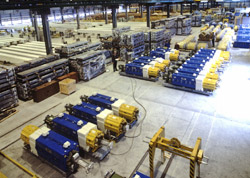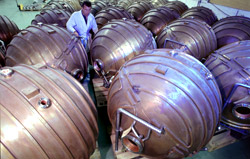Related links
- In their own words: Herwig Schopper – Winning approval
This website is no longer maintained. Its content may be obsolete. Please visit http://home.cern for current CERN information.
Building LEP was an ambitious project. In addition to the state-of-the-art accelerator (the largest at the time) and detectors, the construction phase involved excavating a 27 km tunnel about 100 m underground with four huge underground caverns to house the detectors.
The LEP story began in the late 1970s when physicists belonging to the CERN Member States got together to discuss the long-term future of high-energy physics in Europe. A new picture of fundamental processes (unification) was emerging and LEP would be the machine to study it. After a history built on proton accelerators, the idea of an electron-positron collider was a break with tradition for CERN. But since the results of electron and positron collisions are far easier to interpret than collisions between protons and antiprotons (which were on CERN’s more immediate horizon with the UA1 and UA2 experiments), the LEP proposal won through. The accelerator was formally approved in 1981.
Civil engineering work on LEP began on 13 September 1983. The presidents of CERN’s two host countries, François Mitterrand of France and Pierre Aubert of Switzerland, symbolically broke the ground and laid a plaque commemorating the inauguration. Although much of the necessary infrastructure for the new accelerator was already in place (such as CERN’s existing accelerator complex to pre-accelerate the electrons and positrons for LEP), many new facilities were needed. The most obvious of these was the 27 km tunnel that housed the machine, along with the experimental halls and surface buildings. Transfer tunnels joining the Super Proton Synchrotron accelerator to LEP were also needed, as were buildings to house a linear accelerator (linac) and storage rings to make and accumulate electrons and positrons. Despite the major undertaking, progress was impressive. By the end of 1984, the buildings for the linac and the electron-positron accumulator were complete and 10 of the 18 access shafts had been excavated.
 All LEP magnets were manufactured and ready to be installed at the end of 1987. The innovative dipole magnets were made of plates of steel with the intervening spaces filled with concrete. LEP also had quadrupole focusing magnets, and sextupole magnets to correct the momenta in the particle beams. The full set of magnets for LEP ran to 3368 dipoles, 816 quadrupoles, 504 sextupoles, and 700 other magnets to make small corrections to the beams’ orbits.
All LEP magnets were manufactured and ready to be installed at the end of 1987. The innovative dipole magnets were made of plates of steel with the intervening spaces filled with concrete. LEP also had quadrupole focusing magnets, and sextupole magnets to correct the momenta in the particle beams. The full set of magnets for LEP ran to 3368 dipoles, 816 quadrupoles, 504 sextupoles, and 700 other magnets to make small corrections to the beams’ orbits.
On 8 February 1988, the excavation of the tunnel was completed and the two ends of the 27 km ring came together with just 1 cm of error. A beam was injected into the first 2.5 km of the ring towards the end of the same year, and the first beam circulated on 14 July 1989. Collisions came one month later on 13 August, just 5 years and 11 months after the ground-breaking ceremony.
During its lifetime, LEP received several upgrades. By the time the accelerator was closed, its energy was more than double the value it started with. Even when LEP was still on the drawing board, a far-sighted R&D programme into superconducting ‘accelerating cavities’ was put in place to allow the accelerator to reach higher energies.
 New cavities were installed from 1996 onwards and by 1998, a total of 272 superconducting cavities provided sufficient power to produce collisions with a maximum energy of 189 GeV. The final 16 cavities were installed the following year, bringing the total collision energy to 192 GeV. But there was better yet to come.
New cavities were installed from 1996 onwards and by 1998, a total of 272 superconducting cavities provided sufficient power to produce collisions with a maximum energy of 189 GeV. The final 16 cavities were installed the following year, bringing the total collision energy to 192 GeV. But there was better yet to come.
The engineers working on LEP decided to push the superconducting cavities beyond their nominal limit. The collision energy was taken up to 202 GeV by September 1999 and remained at this value for most of the last month of that year. CERN’s accelerator physicists pulled out all the stops to push the accelerator's energy as high as possible to maximise the chances of a new discovery. Eight old copper cavities were put back into service and the superconducting cavities were pushed still harder. Originally foreseen to produce electron-positron collisions at energies up to 200 GeV, LEP achieved a final value of 209 GeV, giving experiments a final chance to explore unknown territory, before the eventual shut down at the end of 2000.
Members of government from around the world gathered at CERN on 9 October 2000 to celebrate the achievements of LEP and its 11 years of operational life. Two months later, engineers started to dismantle the machine to make space in the tunnel for the LHC – the new flagship accelerator to push physics to another domain.